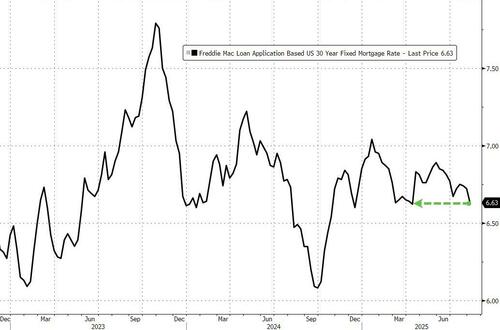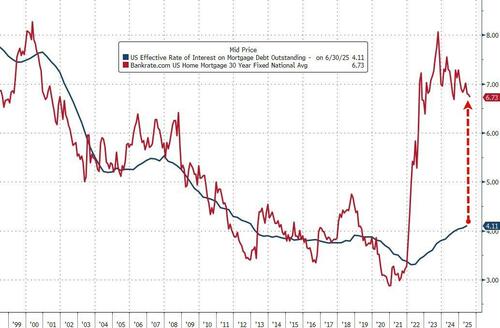Authored by Naveen Athrappully via The Epoch Times,
The average 30-year fixed-rate mortgage fell to 6.63 percent for the week ending Aug. 7, the lowest level since April, according to new data from Freddie Mac.
“The decline in rates increases prospective homebuyers’ purchasing power and our research shows that buyers can save thousands by getting quotes from a few different lenders,” Sam Khater, Freddie Mac’s chief economist, said in an Aug. 7 statement.
In an Aug. 7 commentary, Lisa Sturtevant, chief economist at real estate data company Bright MLS, said that while mortgage rates dropped for the third straight week, it isn’t clear whether the trend will continue.

Rates could fall if the economy seems to be on a decline, or may remain high if inflation risks are elevated, she added.
Sturtevant said buyers were also holding back from purchasing homes due to factors such as general uncertainty. Meanwhile, sellers are holding back as they don’t think they’ll get their desired price in the current market, said the chief economist.
“There will be a lot of data coming out in the weeks ahead that could help us get a better handle on where mortgage rates will trend as we head into fall. But it’s very likely that a lot of the data will send conflicting signals,” Sturtevant said.
“The best thing a prospective home buyer can do is to be sure they have their financial ducks in a row and work with a trustworthy and knowledgeable real estate professional so they can be prepared to act if and when rates drop further.”
A cooldown in home price growth and supplies outstripping demand are also contributing toward favorable conditions for buyers, real estate brokerage Redfin said in an Aug. 7 statement.
A person with a monthly housing budget of $3,000 can now afford a higher-priced home due to the lower mortgage rates.
Many sellers are willing to renegotiate prices, with some accepting bids under the asking price or providing freebies to close the deal, according to the brokerage.
“Serious homebuyers should consider taking this window of opportunity to act fast and lock in a mortgage rate,” said Chen Zhao, Redfin’s head of economics research.
“Last week’s soft jobs report ups the chances of the Fed cutting interest rates in September. The market’s anticipation of that cut has already pushed mortgage rates down, and there’s no guarantee they’ll fall further. There’s a chance mortgage rates could fluctuate when more economic data is released in the coming weeks.”
Fed Rates, Affordability
In its recent July meeting, the Federal Reserve kept its benchmark interest rate unchanged for the fifth straight time in a range of 4.25-4.5 percent.

The Fed rate is a major influence on mortgage rates. The longer the Fed keeps its benchmark rates higher, the more difficult it typically would be for mortgage rates to come down.
Federal Reserve Bank Chairman Jerome Powell told reporters that the agency has adopted a wait-and-see approach.
“Higher tariffs have begun to show through more clearly to prices of some goods, but their overall effects on economic activity and inflation remain to be seen,” he said.
At the policy meeting, Fed Board of Governors member Christopher Waller and Fed Vice Chair for Supervision Michelle Bowman dissented on keeping rates stable and advocated for rate cuts.
Bowman echoed the sentiment recently after Bureau of Labor Statistics data showed that July added a smaller-than-expected 73,000 new jobs. The unemployment rate rose to 4.2 percent, and the agency revised previous data to show job gains had slowed significantly over the past three months.
During an Aug. 9 speech at the Kansas Bankers Association, Bowman said that there may be a “significant softening in labor demand.”
“My Summary of Economic Projections includes three cuts for this year, which has been consistent with my forecast since last December, and the latest labor market data reinforce my view,” she added.
The Fed has three more policy meetings this year. If the central bank were to cut the benchmark rates in any significant manner, mortgage rates could drop further.
According to an Aug. 6 Redfin statement, the income needed to afford a median-priced home has decreased in 11 of the 50 most populous American metro areas, with the company attributing the better affordability to a decline in home prices.
Oakland, California, saw the largest dip, with required income falling 4.6 percent year-over-year. This was followed by West Palm Beach, Florida; Jacksonville, Florida; San Diego, California; and Tampa, Florida.
“We’ve been in a buyer’s market for the past eight months. If your home isn’t in 10/10 condition and priced at or below market value, it’s going to linger on the market,” said Katie Shook, a Redfin Premier real estate agent in Phoenix.
Loading recommendations…


